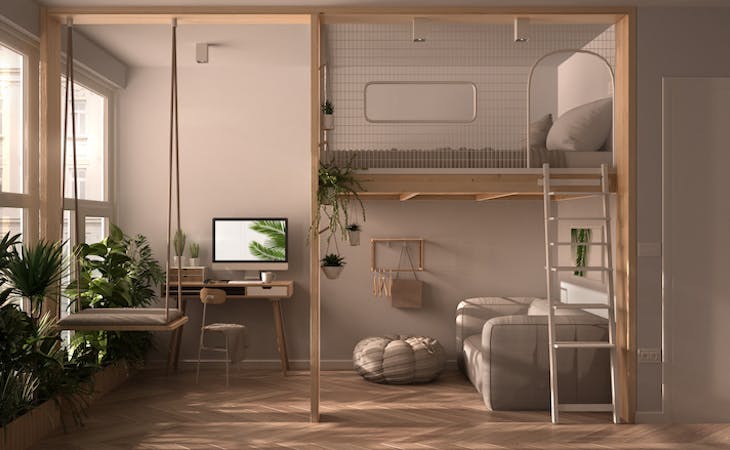Loft flooring is the process of adding suitable flooring to create a usable space in a loft area. It is essential for enhancing the functionality and aesthetics of the space, providing a stable surface for various activities.
Proper loft flooring can improve the insulation and safety of the area, making it more comfortable and secure. When deciding on loft flooring options, considerations such as budget, intended use, and installation process are crucial. From traditional wooden boards to modern laminate or engineered wood, there are various materials available to cater to different preferences and requirements.
Additionally, carpet tiles or vinyl flooring can offer a more cost-effective solution for those on a tight budget. By carefully selecting the right type of loft flooring, you can transform your loft into a practical and stylish living space.

Credit: www.saatva.com
The Benefits Of Loft Flooring
Maximize your space with loft flooring! By adding a solid floor to your loft, you can create a functional and accessible storage area, increasing the value of your property. With loft flooring, you can easily organize and store items, making the most out of your available space.
Maximizing Space
Loft flooring helps maximize the usable space in your attic, creating an additional area for storage or a new living space.
Improving Insulation
Proper loft flooring contributes to better insulation, helping to maintain a consistent temperature in your home.
With loft flooring, you can make the most of your loft area, creating a functional space for various purposes.
Maintaining a well-insulated loft through proper flooring can reduce energy bills and enhance overall home comfort.
By installing loft flooring, you can easily access and organize stored items, keeping your space clutter-free.
A well-insulated loft with the right flooring can contribute to a healthier indoor environment.
Enhance the functionality of your attic with loft flooring and unlock the full potential of your home.
Types Of Loft Flooring Materials
Engineered wood is a durable and versatile option for loft flooring. It is made from layers of real wood compressed together, providing strength and stability.
Laminate loft flooring is affordable and easy to install. It mimics the look of hardwood but is more budget-friendly and resistant to scratches.
Carpet tiles are a popular choice for loft flooring as they offer comfort and can easily be replaced if one tile gets damaged. They come in various colors and patterns to suit any style.
Choosing The Right Loft Flooring
When it comes to choosing the right loft flooring, several factors need to be considered, such as durability, maintenance, and aesthetic appeal. Making the right choice for your loft flooring can not only enhance the visual appeal of your space but also provide practical and long-lasting benefits. Let’s delve into the key aspects to consider when selecting the perfect loft flooring.
Durability And Maintenance
Durability and maintenance are crucial factors to consider when choosing loft flooring. The loft area is often used for storage, and therefore, the flooring needs to withstand the weight of stored items and regular foot traffic. Opting for durable materials such as engineered wood, laminate, or vinyl can ensure longevity and minimal maintenance requirements. These materials are also resistant to moisture, preventing potential damage from condensation in the loft space.
Aesthetic Appeal
Aesthetic appeal is an important consideration when selecting loft flooring, as it can transform the entire look and feel of the space. Wood flooring offers a timeless and elegant aesthetic that can add warmth and character to the loft area. Additionally, light-colored flooring can create a sense of spaciousness, making the loft feel larger and more inviting. Considering the existing decor and color scheme of the space is essential when choosing flooring that complements the overall design.
Installation And Maintenance Tips
When it comes to loft flooring, proper installation and regular maintenance are key to ensuring the longevity and durability of your loft space. In this section, we will discuss important tips on how to install loft flooring and how to properly care for it to keep it in excellent condition for years to come.
Subfloor Preparation
Before installing loft flooring, it is essential to prepare the subfloor to create a stable and level surface for the new flooring. Follow these steps to ensure a successful installation:
- Clear the area: Remove any debris, old flooring, and loose nails from the subfloor.
- Inspect for damages: Check the subfloor for any damages, such as rot or water damage. Replace or repair any affected areas before installing the new flooring.
- Level the surface: Use a leveling compound to fill any low spots or uneven areas on the subfloor. This will prevent the new flooring from sagging or shifting over time.
- Moisture barrier: Install a moisture barrier, such as a plastic sheet or underlayment, to protect the loft flooring from moisture damage.
Cleaning And Care
To keep your loft flooring looking its best, regular cleaning and proper care are essential. Follow these maintenance tips to ensure the longevity of your flooring:
- Sweep and vacuum regularly: Remove dust, dirt, and debris from the loft flooring by sweeping or vacuuming with a soft brush attachment.
- Spot cleaning: Immediately clean up any spills or stains to prevent them from seeping into the flooring. Use a mild cleaning solution and a soft cloth to gently blot the affected area.
- Avoid harsh chemicals: Avoid using abrasive cleaners or harsh chemicals that can damage the loft flooring. Stick to mild detergent and water for general cleaning.
- Protect from scratches: Place felt pads or furniture coasters under heavy furniture to prevent scratches. Avoid dragging furniture across the flooring.
- Control humidity levels: Maintain a balanced humidity level in the loft space to prevent the flooring from warping or swelling. Use a dehumidifier during humid seasons.
By following these subfloor preparation and cleaning tips, you can ensure that your loft flooring remains in excellent condition for years to come. Proper installation and regular maintenance will not only enhance the aesthetics of your loft space but also extend the lifespan of your flooring investment.
Cost Considerations And Return On Investment
Maximize ROI by considering cost-effectiveness when installing loft flooring, ensuring a practical investment that adds value to your property. Evaluate expenses for materials and installation against potential long-term benefits to make informed financial decisions.
Cost Considerations
When it comes to loft flooring, one of the primary concerns for homeowners is the initial investment. The cost of installing loft flooring will depend on several factors such as the size of the loft, the type of flooring materials used, and whether additional support or insulation is required. While it’s important to consider the upfront expense, it’s equally crucial to evaluate the return on investment (ROI) in terms of added property value. Let’s explore the cost considerations and potential ROI associated with loft flooring.
Initial Investment
The initial investment for loft flooring can vary greatly depending on individual requirements and preferences. Typically, the costs include materials, labor, and any additional supports or insulation needed. Here’s a breakdown of the potential expenses:
- Materials: The cost of loft flooring materials will largely depend on the type of flooring chosen. Options range from budget-friendly laminate or engineered wood to more premium choices like solid hardwood or carpeting. It’s important to choose materials that are durable, easy to maintain, and suitable for the desired purpose of the loft space.
- Labor: Hiring professionals for the installation of loft flooring is recommended to ensure a high-quality and long-lasting result. The labor costs will depend on the complexity of the project, the size of the loft, and the type of flooring materials used. It’s advisable to obtain multiple quotes from reputable contractors to ensure a fair price.
- Additional supports and insulation: Depending on the existing structure of the loft, additional supports may be required to ensure the flooring is stable and safe. Insulation is also essential to preserve heat and energy efficiency. The costs for these additions will vary depending on the specific needs of the loft and the type of materials used.
By considering these factors when budgeting for loft flooring, homeowners can estimate the initial investment required to transform their loft space.
Increased Property Value
Investing in loft flooring can offer a significant boost to the overall value of a property. Here are several ways loft flooring can contribute to increased property value:
- Expanded usable space: By converting the loft into a functional area with proper flooring, homeowners effectively increase the usable space in their property. This added space can be utilized as an extra bedroom, a home office, or even a recreational area, making the property more attractive to potential buyers.
- Enhanced functionality: A well-finished loft flooring allows homeowners to maximize the functionality of their property. Whether it’s providing additional storage or creating a dedicated workspace, a versatile loft space increases the appeal and desirability of the property.
- Improved aesthetics: Loft flooring can greatly enhance the overall aesthetics of a property. Choosing high-quality materials and a well-executed installation can significantly elevate the visual appeal of the loft, making it an appealing feature to prospective buyers.
Ultimately, the increased property value resulting from loft flooring can provide a strong ROI. Homeowners can enjoy the benefits of an improved living space while potentially achieving a higher selling price when it comes time to sell their property.
:max_bytes(150000):strip_icc()/transforming-furniture-for-small-spaces-4058276-0490f69ad6114680920b7545b42abb92.jpg)
Credit: www.thespruce.com
Frequently Asked Questions On Loft Flooring
What Is Loft Flooring And Why Is It Important?
Loft flooring refers to the installation of a sturdy and durable flooring system in your attic or loft space. This is important because it provides a safe and stable surface to walk on, increases the storage capacity of your loft, and helps to insulate your home effectively.
How Do I Choose The Right Loft Flooring Material?
When choosing loft flooring material, consider factors such as load-bearing capacity, moisture resistance, ease of installation, and budget. Popular options include chipboard, plywood, and engineered wood. It’s best to consult with a professional to determine the most suitable material for your specific needs.
Can I Install Loft Flooring Myself Or Do I Need Professional Help?
Installing loft flooring can be a DIY project if you have the necessary skills and tools. However, it’s important to note that improper installation can lead to structural issues or safety hazards. If you’re unsure or want to ensure the best results, it’s recommended to enlist the help of a professional loft flooring installer.
Conclusion
Choosing the right loft flooring is essential for maximizing space and enhancing the functionality of your property. With the options of wooden, chipboard, or steel loft boards, each comes with its own benefits and considerations. By understanding your needs and the suitability of each type, you can make a well-informed decision for a durable and efficient loft flooring solution.


